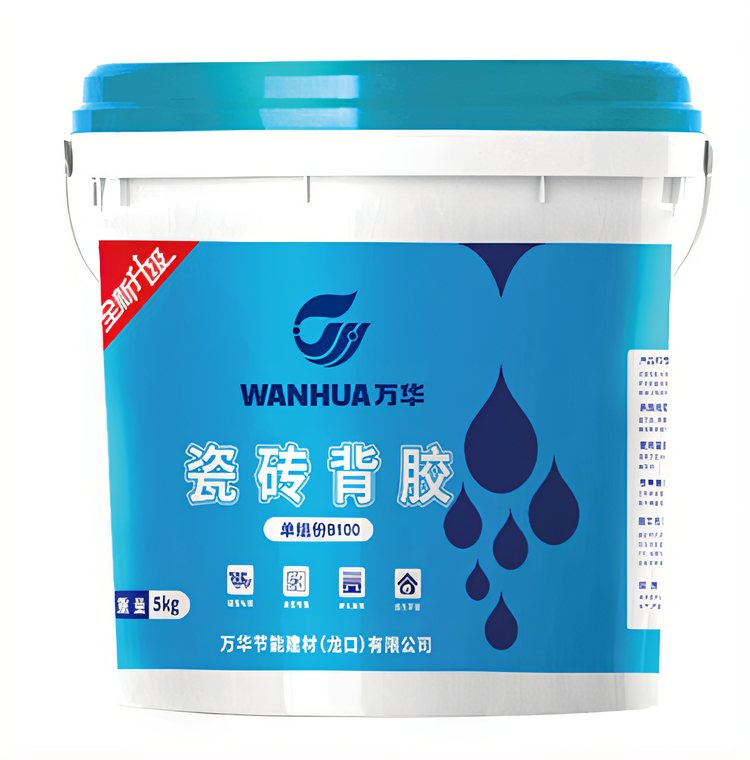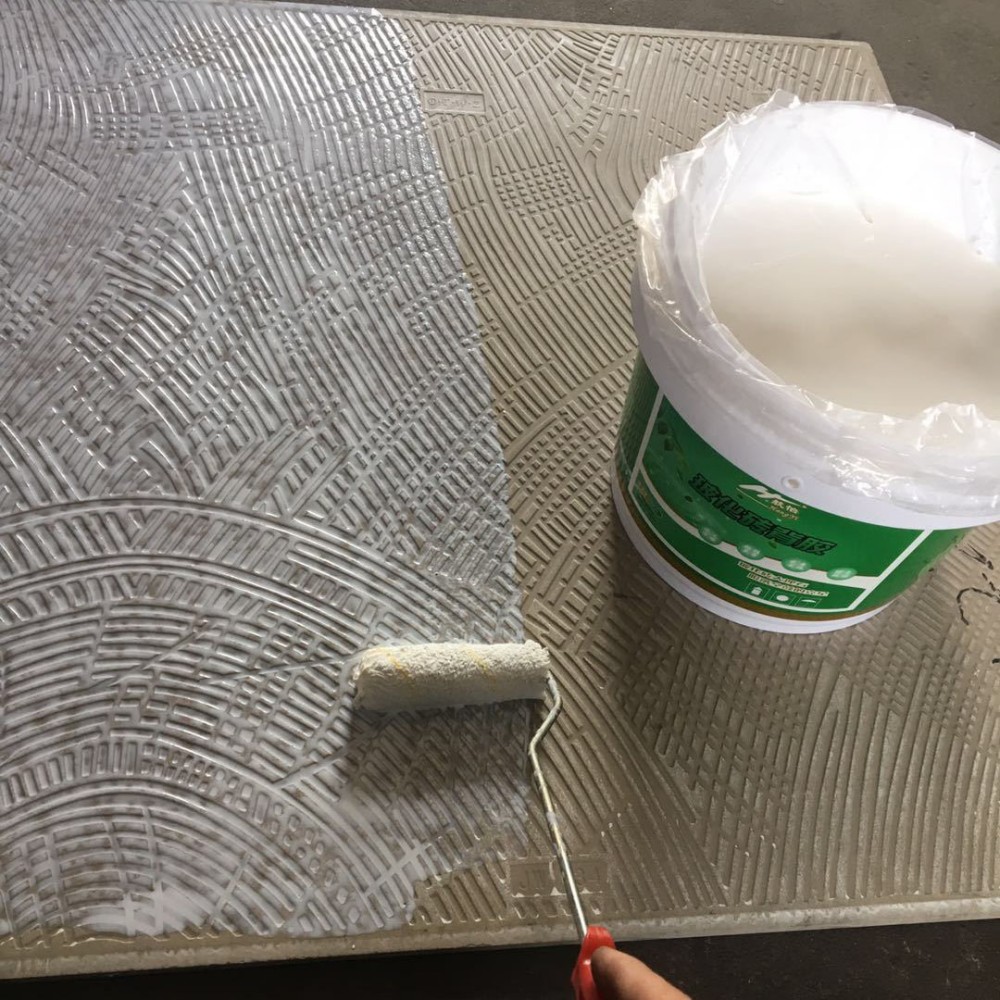

In the tile laying construction, tile back adhesive plays a crucial role. It can effectively improve the bonding strength between tiles, stones and bonding materials, and practically solve the common problems such as hollowing and falling off when tiles and stones are wet-laid. At present, the mainstream tile back adhesives on the market are mainly divided into two categories: dry-waiting type and immediate-laying type. Different types of back adhesives have significant differences in characteristics, construction requirements and waiting time, which will be introduced in detail for everyone below.
1. Types of Tile Back Adhesives and Waiting Time for Laying
(1) Dry-waiting Tile Back Adhesive
Dry-waiting tile back adhesive mainly has two forms: two-component and one-component liquid, which have different characteristics, construction processes and drying requirements.
- Two-component Tile Back Adhesive: Its raw materials are composed of acrylic emulsion, high polymer and inorganic materials. When in use, it is necessary to fully stir and mix component A and component B in accordance with the specified proportion, and then evenly apply it on the back of the tile. Due to its characteristics, it needs to wait for 24 hours to be completely dried after application before laying tiles with cement mortar. This type of back adhesive has high requirements for construction operations. It is necessary to ensure accurate proportion and uniform mixing in the mixing link, and also ensure uniform thickness and full coverage during application. Moreover, it must be used together with tile adhesive, so the construction process is relatively cumbersome, which will increase a certain amount of construction time and labor cost.
- One-component Liquid Tile Back Adhesive: Its main components are acrylic emulsion-based pressure-sensitive adhesive and glue. Most of this type of back adhesive on the market needs to wait for 2-3 hours to dry before being laid on the wall after application. However, the specific drying time is not fixed and will be affected by factors such as the ventilation conditions, air humidity and temperature of the construction environment. If the construction environment has good ventilation, low humidity and suitable temperature, the drying time may be slightly shortened; on the contrary, if the environment is humid, poorly ventilated or the temperature is low, the drying time will be prolonged accordingly. The reason why it is necessary to wait for the back adhesive to dry before laying is that the water in the back adhesive acts as a carrier, bringing the adhesive components to the back of the tile. In the natural environment, the water gradually evaporates, and finally the adhesive substance left on the back of the tile can form a firm bonding layer. The bonding is realized through the double-sided adhesive principle: one side is closely bonded to the back of the tile, and the other side is firmly combined with the dried cement mortar.
(2) Immediate-laying Tile Back Adhesive
Immediate-laying tile back adhesive is favored by many constructors and owners due to its convenience and high efficiency, and mainly includes two types: one-component paste and one-component emulsion.
- One-component Paste Tile Back Adhesive: Most constructors and owners prefer this type of product. Unlike emulsion back adhesive which needs to wait for several hours to dry, it can be laid immediately after being scraped and applied, without changing the traditional construction method at all, which greatly simplifies the construction process and makes the installation very convenient. Taking Jingdi Tile Back Adhesive J-200 as an example, its main raw materials also include acrylic emulsion, high polymer and inorganic materials. It is developed through technical upgrading on the basis of two-component back adhesive and is also the earliest one-component immediate-laying back adhesive product. When in use, it only needs to be evenly scraped and applied on the back of the tile, and then the tile can be directly laid with cement mortar, which greatly saves the construction waiting time and improves the construction efficiency.
- One-component Emulsion Tile Back Adhesive: It is an upgraded product further optimized on the basis of one-component paste tile back adhesive. It mainly improves the problems that the paste tile back adhesive cannot be constructed by brushing and the laying area is limited. It not only improves the construction convenience (constructors can choose more flexible construction methods such as brushing according to the actual situation), but also reduces the construction cost. While ensuring the bonding effect, it can better adapt to tile laying projects of different scales.
2. Precautions for Tile Back Adhesive Construction
In the process of tile back adhesive construction, whether each link is operated in a standardized manner will directly affect the final laying quality and bonding effect. Therefore, the following precautions must be strictly followed:
- Requirements for Applying Back Adhesive Slurry: For tiles of different specifications, appropriate application methods should be selected. For small-sized vitrified tiles, a row brush can be used for application, but it is necessary to avoid applying too thinly or using the spot-coating method. Applying too thinly will lead to insufficient thickness of the adhesive layer, which cannot give full play to the bonding effect of the back adhesive; the spot-coating method refers to applying part of the back adhesive only at both ends of the tile. Although this method can save a certain amount of materials, it will make the parts without back adhesive prone to hollowing after laying. Once affected by external forces, the destructive force will be greatly increased, and even the tiles may fall off, seriously affecting the laying quality. Therefore, these two non-standard application methods must not be used in construction.
- Specifications for Back Adhesive Proportioning: When preparing the back adhesive slurry, the proportion must be strictly in accordance with the provisions of the product manual. If too little powder is added during the proportioning process, the prepared slurry will be too thin, and after being applied on the back of the tile, it will be too thin and uneven. This situation is mostly caused by constructors failing to operate in accordance with the specifications in order to be lazy and save trouble, which will greatly reduce the bonding performance of the back adhesive and cannot meet the quality requirements of tile laying. Therefore, such illegal operations must be eliminated in construction.
- Storage of Tiles After Adhesive Application: The storage method of tiles after the back adhesive slurry is applied on their back is crucial. It is strictly forbidden to stack the tiles with just-applied slurry together, because this will cause the back adhesive between the tiles to stick to each other, destroying the integrity of the adhesive layer and affecting the subsequent laying; at the same time, they cannot be placed in direct sunlight or directly exposed to the shower environment. Direct sunlight will cause the water in the back adhesive to evaporate quickly, which may lead to problems such as cracking and warping of the adhesive layer, affecting the bonding effect; the shower environment will keep the back adhesive in a humid state for a long time, making it impossible to dry normally, which will also reduce the bonding strength. The correct way is to place the tiles with adhesive applied in an indoor environment, leaning against the wall and standing upright, and place gaskets between the tiles. This can not only effectively prevent the tiles from sticking to each other, but also ensure air circulation around the tiles, which is conducive to the normal drying of the back adhesive and ensures the smooth progress of the subsequent laying work.
- Application of Adhesive and Reservation of Tile Joints: When applying the adhesive (such as tile adhesive, cement mortar, etc.), it is necessary to ensure that the adhesive is fully applied and spread evenly, so that the adhesive can evenly cover the back of the tile and the surface of the base layer, and there should be no gaps in the middle. If the adhesive is not applied fully and there are gaps, the bonding between the tile and the base layer will be insecure, and problems such as hollowing and falling off are likely to occur during use, which will seriously affect the overall effect and service life of tile laying. In addition, when laying vitrified tiles on the wall, it is necessary to reserve appropriate tile joints. This is because vitrified tiles will generate expansion and contraction stress when the temperature changes. Reserving tile joints can provide a certain space for the expansion and contraction of the tiles, effectively release the expansion and contraction stress, avoid cracks and arching of the tiles due to stress concentration, and ensure the stability and aesthetics of tile laying.

